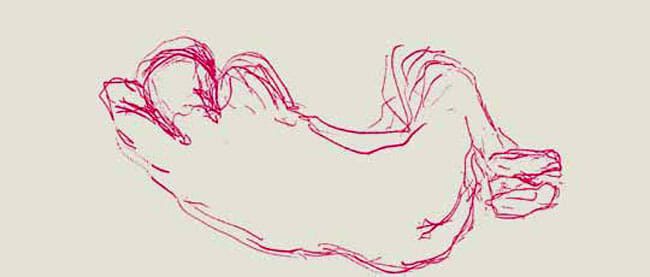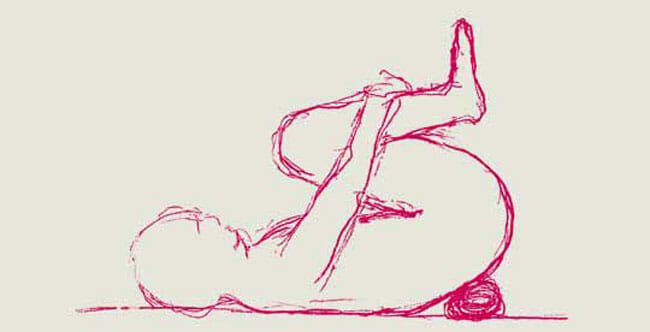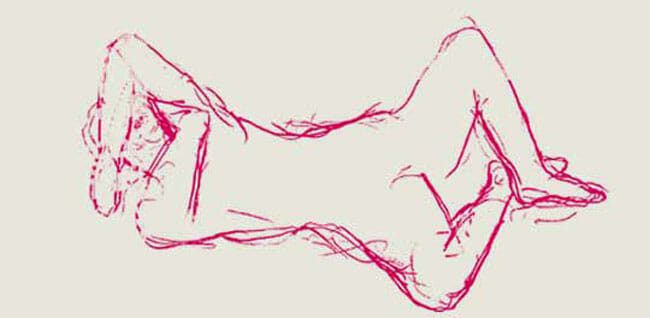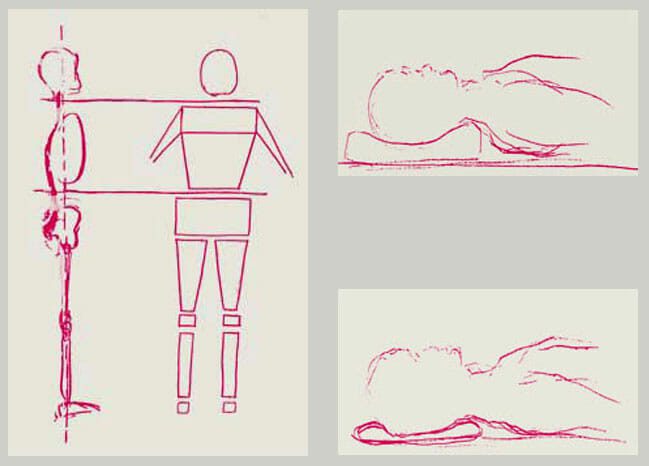1. Health is a life process – not a consumer product
2. Life means movement – so does sleep
3. The learning capacity of the human nervous system
4. Restructure the body – or lose yourself in the mattress
5. The theory of the "spine-friendly" mattress
6. The weak points of the spine.
1. Health is a process of life – not a consumer product
When buying a mattress, the question naturally arises as to whether there are certain health criteria to consider when making a choice. Because today there is hardly a person who is not affected in some way by low back pain.
Even if you do not have any special requirements for a mattress at first, except that you want to feel comfortable and sleep well on it, it is not easy to make a decision with the variety of products on offer. Some suppliers emphasize the quality of their materials, others a special processing technique, still others special functions. And all praise their mattresses as healthy. In order to increase credibility, the vendors try to justify their statements scientifically.
The fact is, however, that there is little evidence in classical medicine about how the human body organizes itself while lying down or. How the spine stretches when lying down and how the organs rearrange themselves in the connective tissue.
Despite this fact, mattress sellers simply claim that the sole purpose is to relieve the spine and that there must be appropriate support zones. In addition, terms such as "correct for intervertebral discs" or "orthopedically correct" are used to give medical authority to the claim.
If you look through the publications and presentations of the well-known mattress manufacturers under these premises, you come to the surprising conclusion that there is currently not one supplier who includes the dynamics of the human musculoskeletal system in his argumentation.
The mattress manufacturers obviously do not know anything about the integration ability of the nervous system nor about the connection between "tonic" muscle activity, voluntary muscle activity and relaxation (see note below).
We can say this without further ado, because the knowledge of the dynamic functions of the human "musculoskeletal system" would result in a completely different appearance. The occupation with the neuromuscular organization of the body leads to the insight that the body is in principle very mobile and far more change and adaptable, than one generally assumes. And this insight leads to a completely different conception of lying down.
The traditional way of consulting for back problems is well known: People are approached by confirming their orientation to their suffering, while on the other hand reinforcing the belief that the body is fixed and increasingly stiff. Attuned to this disease perspective, it is more or less self-evident, as recommended, to buy a particularly supportive, "orthopedically correct" mattress.
The concept of Dynamic Lying, on the other hand, directs the attention of the human being to his liveliness, his mobility and to his possibilities for change. We (as mattress suppliers) do not want to and cannot pretend that health can be bought or consumed. Health resp. Recovery is not something external and can best be described as a process in which the person is inwardly and actively involved. The consequence of this is that the bed takes second place in the consultation and the person takes first place.
Annotation:
"Tonic" or "anti-gravity" musculature aligns the body against the earth's gravitational field, controlled by the autonomic nervous system. The "voluntary" and "conscious" muscle activities often override this natural alignment process. And this, in turn, usually happens completely unnoticed, because many muscular activities escape consciousness through habituation. Thus, hardly anyone knows that all emotional impulses are connected with patterns of muscular excitations.
2. Life means movement – so does sleep
When we say that people come first, we mean that we can hardly sell a "healthy" bed if we do not also take seriously the people who, when buying a bed, are also looking for a remedy for their back problems. Because we know that the complaints cannot be eliminated by a new bed, since it is highly probable that they were not caused by the previous bed either. But if one changes one's movement behavior, a properly selected mattress can help support the stimulated restructuring processes. However, we do not only want to point out such general correlations to our customers, but also to give them, as far as possible, concrete suggestions and practical assistance.
2.1 Support through "back prostheses"
The different approaches to the subject of "lying and sleeping" are an expression of a different view of life. We want to clarify this in the comparison. As it seems, most mattress suppliers understand the human being as a creature that has not properly coped with the evolution to the upright human gait. Therefore, according to the opinion, the supposedly overloaded spine must be treated gently and relieved of pressure. One might think that mattress salesmen are faced with the question that confronts a packaging technician who has to safely store a figure with irregular shapes: in the side view, the buttocks arching backwards; in the front view, the shoulders protruding to the sides and the curved pelvis. "Packaging-wise," of course, this is not a problem: in the area of the shoulder and pelvis, recesses ("z. B, shoulder lowering") must be created, while the slimmer waist of the figure requires support ("lumbar support").
The philosophy of most bed and mattress manufacturers is not only based on similar considerations, it also comes to the same conclusions, without taking into account the difference that we are dealing here with the bedding of a living, dynamic and very adaptable organism, whose inner nature is determined by movement.
2.2 Development of body awareness
Our dynamic approach is based on the Feldenkrais Method (see below) and on the experience that the "everyday phenomenon of back pain" is not a static problem caused by developmental history, but a cultural one. This is because a process of exclusion of movement possibilities begins in childhood – in that only a few posture and movement patterns are selected and learned from the variety of possible ones. This leads to a lack of alternatives for the adult when discomfort arises. These are needed when the familiar and ingrained movement patterns cause problems. He then has no other choice but to persist or to continue in the old way and suffer from it. In this way, the problems will continue to increase until possibly serious damage occurs.
The dynamic approach, on the other hand, aims to open up new ways for people to deal with their bodies. It is a matter of learning to do the everyday and natural movements, that is, what you already know, in a different way. Because this is the only way to permanently relieve superfluous tension and avoid new "dead ends" (i.e. movement bottlenecks). An important prerequisite for this is the sensitive and differentiated perception of one's own body.
2.3 What the visitor can expect
We would like to pass on our experience, which we have gained in theory and practice in dealing with the subject of "lying, physical organization and mattresses". So, first of all, we advise our customers to take enough time to relax the extensor muscles of the back when trying out the individual mattresses. For only then will the sensitivity for a more accurate assessment be able to arise. We would also like to show our customers how to move during mattress reclining, the frequent getting up and lying down, without unnecessarily straining the cervical and lumbar spine. In addition, we want to help analyze complaints associated with certain lying positions in order to find alternatives to the usual treatment of problems.
If you take enough time and rest to try out lying down, and develop an awareness of the differences through a little patience and attention, you will quickly become aware of your body's centers of gravity and also your sensitivities. He may discover that the contours of the back change as a result of attentive awareness and sensitization of the body, and that the need for support is a relative matter. The back does not always remain the same, what is perceived as pleasant today may be painful tomorrow and vice versa. It is the person himself who can take possession of his back again and change, and not the bed.
3. The learning capacity of the human nervous system
3.1 The peculiarity of lying down – the opposite of standing up.
Standing that means the alignment of the body against the force of gravity. Since the head, neck, chest, pelvis and legs are superimposed, the weights add up from top to bottom. The lower a body section is positioned, the more load it has to bear. When lying down, each part of the body has to bear only its own weight. Lying down, this is not "standing in a horizontal position", but it means a completely different organization of the body than when standing upright. e.g. the head assumes a different position in relation to the cervical spine, the shoulders sink and the S-curve of the spine becomes flatter, while the pelvis opens slightly (see illustration). e.g. the head assumes a different position to the cervical spine, the shoulders drop and so does the spine, flattening its curves as the pelvis rotates (see illustration). It also results in a different relationship of muscles, ligaments, connective tissue, bones and organs. Even if most of the muscles that hold the body upright against gravity while standing are now unloaded, this does not mean that all muscles are relaxed.
Standing man in the horizontal position
A standing person turned in the horizontal (above) compared to the alignment of the body of a lying (below). You can see that the body aligns differently and hugs the support surface.
Accustomed patterns of muscular tension, associated with inner attitudes, continue to determine the body. These very personal tensions, which have become almost second nature to human beings, are released only gradually during sleep. And this happens through movement. However, there are other movement impulses that occur during sleep, e.g. Reactions to dreams, to strong tensions and emotional impressions of the previous days.
So lying down and sleeping are not only forms of letting go, but also forms of balancing, connected with biological-organic processes: The body stretches, it gathers and restructures itself. Stimulating and supporting these processes is the goal of "Dynamic Lying". This includes both a certain way of dealing with the body and a certain conception of bed and mattress.
3.2 The organic function of the "locomotor system"
The common, everyday back pain that affects many adults today does not really have any special characteristics, except that it would not be necessary. They come to light as a result of overloads at organic weak points. The causes lie, as already described above, in the culturally conditioned one-sidedness of the movement sequences and in the restriction of the movement variety under the influence of stress and psychological tension. The typical posture of every human being is the result of the formation and acclimatization of individual patterns of movement and feeling. But the embodiment of personal behavior that has grown up in this way is not an inescapable destiny, even if these patterns are so familiar that they appear to be a natural part of one's personality.
Our optimism about the possibilities of change in the human body is based on its biological-organic structure and the almost unlimited integration capacity of the nervous system. Because the reason for the solidification of the body structures is not due to the rigidity of the bone structure, but to the ingrainedness and limitedness of the interaction of the musculature and the nervous system. And this connection is basically open and influenceable!
The human nervous system has the unique ability to constantly restructure itself through individual experience and to establish new nerve connections. This is also the reason for the ease with which people can learn (regardless of age).
Thus, while it is well known that physical posture is structured by the nervous system. But it is little known that the nervous system and thus the anatomy of posture can be reorganized through alternative movement experiences. This is the significant discovery of Moshe Feldenkrais. "Awareness through movement," as Feldenkrais calls his method, is organic learning in which one can experience the fundamental variability of the bodily structure. Learning according to this method is done through light, playful movements, without purpose or pressure to perform. The simplest movement sequences, which otherwise elude perception due to their everydayness and self-evidence, are rediscovered by providing the "curious" nervous system, which is always ready to learn, with functional alternatives. This learning is as immediate and natural as the trial and error learning of a toddler, except that you are aware of what you are doing and experience an unprecedented amount of change.
Well-coordinated spine of a standing person in horizontal position
A well-balanced spine of a standing person rotated to the horizontal (above). With a person lying down, the body is stretched so that the curve of the spine stretches accordingly and becomes flatter.
Shape of the spine on a soft mattress
Positioning the body as shown in the figure below (which is advertised as ideal by one of the leading mattress manufacturers) allows the body to sink deeply at its centers of gravity, so that the spine curves even more instead of stretching out. The weight of the buttocks pulls the pelvis downward, creating a corresponding counterpressure in the small of the back that makes it impossible to extend the spine.
4. Restructure the body or lose it in the mattress
The "organic way" and the "mechanical way
Strongly supported back
The spine is held in position by the support and cannot stretch, even when the large psoas muscles (between the lumbar vertebrae and the femur) have relaxed.
Lying down with the spine stretched
Position on solid surface. The spine can stretch,
as soon as the psoas and back extensors loosen up.
In order to avoid misunderstandings, we would like to emphasize that the concept of "healthy lying – dynamic lying" does not mean giving up the support of the back. It is rather a matter of giving the back no more support than it needs, but no less either. Too much support blocks the process of re-structuring, while too much level support can cause pain, e.g., pain in the back, pain in the back, pain in the back, pain in the back, pain in the back, pain in the back. B. in the case of strong tension or a pronounced hollow back. Pain is often part of the healing process, but if it exceeds the tolerable level, the tense muscle strands harden and also prevent the restructuring process.

In this posture, the muscles cannot exert any traction on the spine, so the lumbar vertebrae can stretch without restriction. An effective back exercise can be performed in this position. However, you need to lie on the floor to do this. Then press the heels into the floor so that the pelvis rolls a little towards the head (the tailbone lifts). Then let go again and roll the pelvis toward the feet (the tailbone tilts toward the floor). This exercise is also called pelvic rocking, it promotes harmonization of the spine. The effect can be increased if you let the rocking movement pass slowly in a diagonal direction, first to one side, then to the other.
This exercise should be done without force, slowly, gently and with attention.
5. The theory of the "intervertebral disc" mattress
As already mentioned, there is a very common model that is supposed to be a proof of the concept of "orthopedically correct mattress". It is a picture of a woman lying on her side, turning her back to the viewer and demonstrating her perfectly straight spine. (See Fig.) This picture is accompanied by a story about the intervertebral discs, which suggests that there is a patent solution for the widespread back problems.
Intervertebral discs, which are elastic, water-binding buffers that lie like hydraulic presses between the individual vertebrae. During the day the intervertebral discs lose some of their fluid, while at night they are replenished. The story now tells that the intervertebral discs can only replenish themselves on the mattresses where the spine aligns straight, and that any other alignment hinders this process and is therefore unhealthy for the back.

The so called "disc friendly" position
5.1 The movement-therapeutic answer
If this theory were correct, it would mean that even during the day one should be careful not to bend the trunk more often in order to keep sufficient reserves of intervertebral disc fluid. It would also mean that the entire human race, before these mattresses existed, always slept in a way that was detrimental to the back.
However, the stresses on the intervertebral discs generally result from the upright posture of the person, in which the spine must support and balance the entire weight of the upper body. As soon as the body is in the horizontal (d. h. in the lying position), the intervertebral discs can fill up again. (x) Slight rotations and inclinations of the spine are quite natural and do not hinder its regeneration. The transport of intercellular fluids is even supported if the lying position is changed from time to time. Of course, this also changes the alignment of the spine each time.
Regardless of this, there is probably no one who will spend the whole night in the special side position shown here. It is quite unstable because of the stretched, superimposed legs and, moreover, it is stiff and uncomfortable. Most people will bend their legs a bit and move their bottom shoulder toward their head or pelvis, shifting it back or forward a bit to better hug the support and thus distribute the support weight (according to the illustration below).
Natural relaxed sleeping position
(x) In an experiment at the University of Ulm, a measuring electrode was implanted in the intervertebral disc of a living person to measure pressure, and then the pressure was measured in various postures and lying positions. It was found that the pressure in the intervertebral disc is independent of how the spine is aligned when lying down. A more detailed description of the experiment can be found here.
6. The weak points of the spine
Why do most complaints occur in the cervical and lumbar spine?? Due to the lack of movement in everyday life, the mobility of the shoulder girdle, thoracic spine and pelvis "rusts", d. h., adhesions form from a spongy, fibrous tissue. Because of this stiffening, all rotational movements eventually occur through only a few cervical and lumbar vertebrae. These are eventually overstressed by the strong continuous load, as well as the intervertebral discs between them. The concept "Healthy lying – dynamic lying" recommends exercises that enable the nervous system to distribute loads and rotations over the entire length of the back again. The mobility of the spine can be recovered so that a continuous flowing connection between the head and the pelvis is established.
6.1 Small steps improve well-being
In many cases, help can be obtained by very simple steps, e.g. B. in case of low back pain, as far as it is caused by tension and overload (in case of a pronounced hollow back). Sometimes it is enough to lie on the side and bend the legs to bring the body back into harmony by forming a "round back.
There is not just one, but many "correct" lying positions, and often existing tensions can be compensated for by conscious, sensitive changes of position. In addition, there are simple, effective movement exercises for almost every problem, which we will gladly teach you during your personal consultation.

Stretching the back muscles and relaxing the large psoas muscles. If this is not enough, we recommend that you get a small roller about 6 to 10 cm in diameter (e.g. placing a rolled-up bath towel) between the bent knees. Then push the upper leg gently and attentively back and forth on the roll for some time. If you then repeat this exercise on the other side, you will soon feel relief in your back.

Exercise with the pelvic roll
Simple exercise to bend your back the other way around: Shape a wool blanket into a roll about 8 cm thick. Then lie down on the floor, place the legs bent and slide the roller crosswise under the pelvis. Now, using your hands to pull your legs firmly to your chest, you will have the healing experience of stretching the aching lumbar vertebrae downward, and the sensitive neck vertebrae will also feel tighter against the floor.

Twisted tangled lying position
An unusual and twisted body position can also contribute to harmonization. The "favorite position" of some people often arises from a natural need for compensation. Why don't you try strengthening your favorite position on purpose or. to exaggerate. You give the muscles the opportunity to let go.
6.2 Do not forget the head
The other critical point in the course of the spine is the transition from the head to the trunk. For the widespread tensions in the area of the neck muscles, specially shaped support pillows made of foam have recently been touted. Firmly formed and strongly supporting pillows, however, have the disadvantage that they hinder the mobility of the head. Yes, the head does not like to move at all, because all other positions than those given by the shape are uncomfortable. To enable rotation, the head must also be raised slightly, and this in turn puts strain on the cervical spine. However, we do not think that one should do without the support of the neck. Provide optimal adjustment e.g. malleable pillows made of buckwheat, spelt or millet hulls. These pillows provide good support of the neck without limiting the mobility of the head. The shape of the cushion is a natural result of this: By moving the head, the shells push themselves into the desired position. Unlike foam and springs, the shells allow for flexible adjustment without exerting pressure. The firmness of the pillows also prevents the head from gradually sinking into an uncomfortable position.

The blocked person (Ida Rolf)
Figure on the left: The blocked person
Due to the stiff shoulder block, the rigidly held rib cage and the immobile pelvis, the rotation of the spine is reduced to two areas, which thus become problem zones.
Illustration top right:
Head and cervical spine (on a shaped foam pillow) are held by the pillow in the assumed ideal position. The movement of the head can only take place via one or two cervical vertebrae and therefore has an even more stressful effect.
Figure below right:
Variable support through a pillow filled with shells. The shells can be shifted at will by head movements and adapted to the neck.